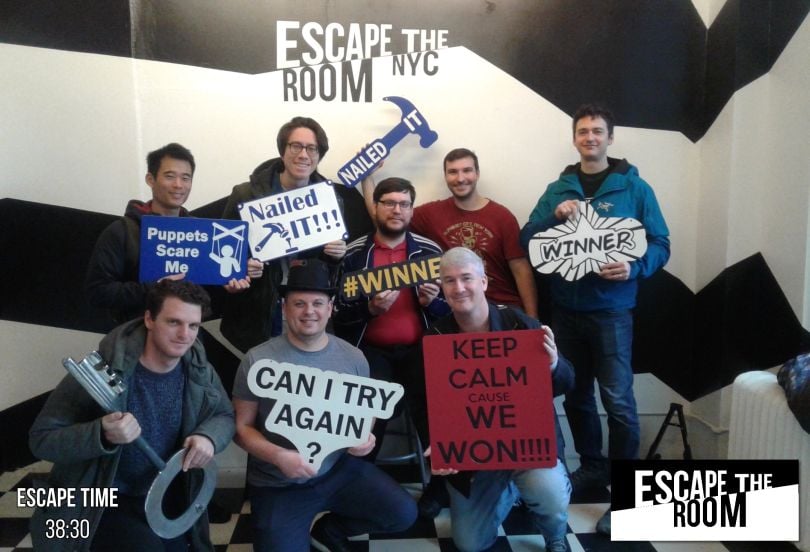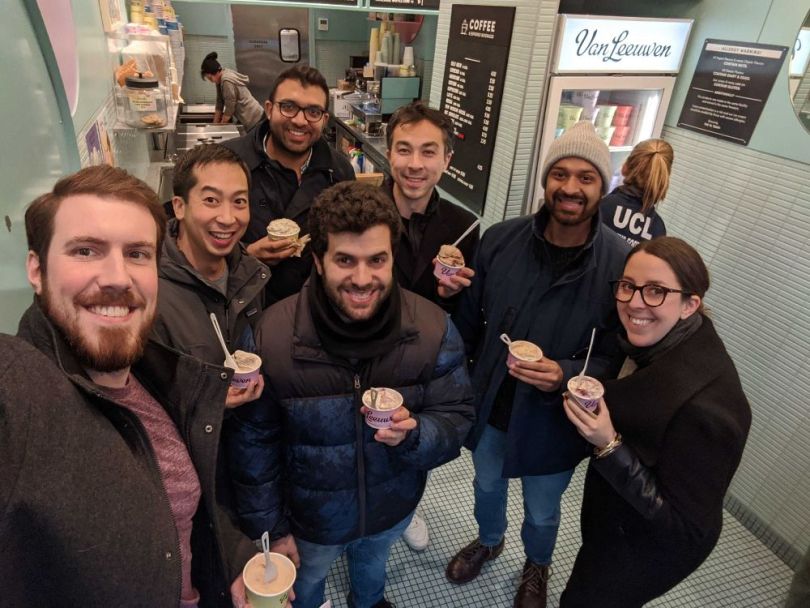Engineering is full of tricky questions, but none may be as head-scratching as the following: “How do you eat a chicken wing?”
Yoo-Nah Park, a software engineer at insurance company Policygenius, said her team uses icebreakers like the aforementioned question to loosen each other up and bring levity to weekly engineering meetings.
A collaborative engineering culture makes challenging projects interesting, informative and, according to the engineers we spoke with, fun. Tech professionals from six local companies — all of which are actively hiring — shared how their engineering teams work together and use innovative tech stacks to write code, design continuous integration pipelines, introduce cool new features and more.

What they do: Ribbon Health is a health care data platform that provides the infrastructure that patients, providers and payers need to ensure up-to-date provider directories, reliable referral management and efficient health care navigation.
Favorite tech tools: “At Ribbon Health, we are using big data frameworks to power every health care decision to be high quality, cost-effective and convenient,” Alex Pasechnik, a staff data engineer, said.
Pasechnik said they use Apache Airflow to orchestrate data collection, Redshift as their data warehouse and Spark and AWS Lambda for data pipelines. “We aren’t locked into existing tech, and we’re free to choose any tools necessary to best meet our goals.”
I think our secret sauce is that we really trust and value everyone on the team.”
Most interesting project: “I am building an automated ingestion engine for data collection from multiple sources,” Pasechnik said. “Every data source is unique, which makes this project really interesting. I enjoy getting creative and thinking through the unique challenges that crop up to make each solution perfect.”
Something unique about your team: Pasechnik said the Ribbon Health team has six values: “Run toward hard problems, put your team first, do what you say, stay hungry, keep improving, practice habits of excellence and build with empathy.”
Those values drive the team’s productivity, Pasechnik said. “Right after I joined, I saw the team launch an entirely new product in less than a month. It felt special to be able to pull that off, and I think our secret sauce is that we really trust and value everyone on the team.”

What they do: Teachers Pay Teachers (TpT) is an online marketplace for original educational resources. More than 75 percent of teachers use TpT to access over 3 million resources for grades Pre-K through 12.
Favorite tech tools: Developer Tooling Engineer Steve Katz said one of his team’s responsibilities is to ensure the code that the software engineers write works as they intend, and that it works with other services that power TpT’s websites.
“In techno-jargon, we refer to this platform as CI (Continuous Integration),” Katz said.
For years, TpT had been using the widely-used Jenkins CI platform for testing, building and deploying code. However, Katz said Jenkins hasn’t been as reliable or flexible as TpT needs for teams to feel confident the changes they’re making to their code won't cause problems for their users. He’s now driving a project to replace Jenkins with a new, open-source CI platform called Brigade.
“Brigade is designed from the bottom up to run completely in Kubernetes, just like the rest of our services. That means it’s very customizable. We can easily adjust settings to run resource-intensive CI steps on very powerful ‘pods,’ but run simpler steps on much smaller pods so we don’t waste money on computing power we don’t need,” Katz said.
I’m always impressed with the level of empathy that people at TpT have toward one another.”
Most interesting project: Along with leading Brigade’s implementation, Katz enjoys the challenge of designing how the various components of the CI pipeline work together.
“We’re responsible for two parts: a command-line tool that we call tpt-cli and a library that provides configurable pipelines using Brigade,” Katz said. “Both our automated CI systems and our developers use tpt-cli to create private deployments of our websites to try out new code and run tests against it. Because it’s used by both humans and machines, we have to make sure it has the right balance of knobs so that things generally work out-of-the-box, but we still have the capability to dig in and change parameters when necessary.”
Katz said designing the interfaces between these tools and the code the developers write is also challenging because of the necessity that the code works with the tools his team creates.
“We have a quick, automated way for developers to check that their code will work with tpt-cli and Brigade by automatically notifying them when the spec that defines the interface between their code and our tools will change without being too burdensome.”
Something unique about your team: “I’m always impressed with the level of empathy that people at TpT have toward one another,” Katz said. “Because the tools my team makes are used by almost all the other engineers at TpT, the choices we make can have a widespread effect.
“Everything we do — whether it’s introducing a cool new feature or inadvertently introducing a bug that breaks something important — is multiplied across the entire engineering team. Because of this, we strive to listen to other teams and get feedback from them about what’s working well and what isn’t so that we can make improvements to our tools. Empathy is critically important for this communication to work.”

What they do: Policygenius makes it easy to compare and buy insurance online. Since their launch in 2014, they have helped over 30 million people get coverage for their families.
Favorite tech tools: “On the front end, we use React and TypeScript, some Redux for state management and Jest for unit testing,” Software Engineer Yoo-Nah Park said. “On the back end we use Ruby on Rails, Postgres, and Go for a couple of microservices.”
Park said she’s most excited about working with React and TypeScript, as well as ramping up unit testings with Jest. “As a team, we are proactive about maintaining and improving our codebase so we are experimenting with React Hooks, auditing and cleaning up our TypeScript to be smarter, and writing unit tests that are more comprehensive and relevant.”
As a team, we are proactive about maintaining and improving our codebase.”
Most interesting project: Park said she’s working on a project to automate the quoting process for a user trying to get home and auto insurance.
“Currently, our operations team collects and enters some missing information to run quotes for each user, which can be tedious and slow,” Park said. “By improving the questions in our consumer-facing flow and restructuring our backend services, we can collect more accurate data about the user’s application to generate better quotes quickly. This will allow our operations team to focus on serving our customers with more complex questions and concerns while reducing wait time for the customer, leading to an overall smoother experience.”
Something unique about your team: Park said she loves getting to know her team better through icebreaker questions at their weekly meetings. “The questions range anywhere from silly, like, “How do you eat a chicken wing?” to thought-provoking: “What is humankind’s best invention?”

What they do: MayStreet is a market data platform that is engineered to make high-quality and complete capital markets data available commercially. Combining ultra-low latency platform architecture with high-precision, full depth-of-book data, MayStreet provides clients with deeper insights into the global capital markets.
Favorite tech tools: MayStreet’s platform is built on a simple tech stack of C++ and Linux, Thomas Georgiades, a lead software developer, said. Since it has to work in a way that is linked and bundled within customer applications, Georgiades’ team must ensure the technology is universally compatible.
“We use Jenkins to manage the build system, and under the hood we have a Docker platform set up to virtualize any environment the client needs. Building on top is where we start getting into AWS usage for scalability as well as a front-end stack primarily using React.”
Understanding the ins and outs of legacy tools can be daunting, but by working with them, you develop great software engineering skills.”
Most interesting project: Georgiades said he’s currently working with a customer to integrate MayStreet’s feed handling library into their market data pipeline. It involves architecting and implementing an entirely new core application that interacts with many pre-existing services the customer uses.
“Integrating a new product with existing applications in a seamless way has been the most challenging part. Understanding the ins and outs of legacy tools can be daunting, but by working with them, you develop great software engineering skills that you can put into practice,” Georgiades said. “Architecting and designing this platform from start to end was extremely fun and rewarding, and now seeing the application in production is the cherry on top.”
Something unique about your team: “The team at MayStreet is exceptionally devoted to creating quality software for our customers,” Georgiades said. “There is a natural collaboration within the team to bounce ideas off each other and come up with great solutions. Almost every wall of our office has a whiteboard on it where most days, you can find a group of engineers discussing a new feature while scribbling on one.”
Even though the team is now working from home, Georgiades said the culture of collaboration is palpable through video calls and remote company happy hours.

What they do: Electric’s proprietary management platform helps companies operate their IT workflows with efficiency. Since launching in 2016, they have grown to more than 300 customers and 10,000 users.
Favorite tech tools: “Our multi-platform chat interface, currently supporting Slack and MS Teams, uses a translation layer to act as an interface between our internal data models and the APIs of the SaaS chat providers we integrate with,” Director of Engineering Chris Scholz said.
Scholz said they use a variety of AWS tools such as SQS, SNS, DynamoDB, Lambda, RDS and API Gateway: “This translation layer could allow us to grow to support an arbitrary number of chat platforms in the future with minimal technical effort. Technologies like BigQuery and Redshift sit atop a data lake, which allows our data science team to expand our feature set with new enhancements based on machine learning.”
Most interesting project: “We love moon-shot ideas and we have no shortage of them,” Scholz said. “We are currently migrating the final few core legacy applications we have across programming languages, cloud platforms and architectural patterns, while simultaneously redesigning and replacing the underlying infrastructure that it all runs on. And we still ship new features on time and in full. It’s like trying to transform a single 747 into a squadron of F-16s in midair, then landing them all on a runway that’s still being built.
Scholz said his team is also in the early stages of migrating their device management solution, one of Electric’s core offerings, to a distributed container-based model.
“This will allow us to replace hundreds of long-lived (and expensive) virtual machines with ephemeral containers that flit in and out of existence, scaling to meet demand when our customers need it and saving operational costs when they don’t,” Scholz said. “Turning a stateful monolith application into stateless, fault-tolerant microservices is already a tall order, but the challenges are magnified when the software isn’t open-source.”
Everyone here is brilliant, helpful and thirsty.”
Something unique about your team: “Electric has, hands-down, the best and most inclusive engineering culture I’ve ever been a part of,” Scholz said. “Everyone here is brilliant, helpful, and thirsty.
“I think the secret ingredient here is hiring people for their potential in a year and not just the role they applied for. If you tell your teammates that you care about them, and are willing to put your money where your mouth is, you will always get the best version of themselves they have to offer.”

What they do: Prescriptive Data has developed an advanced operating system called Nantum OS that connects to building systems, real-time occupancy and any IoT device, allowing their AI algorithms to automate building operations, reducing energy use, utility costs and carbon emissions.
Favorite tech tool: “We use React for the front end; Express Servers for our API; Node.js, PostgreSQL and MongoDB on the back end; and Python for the analytics pipelines,” VP of Engineering Ricardo Cid said. “We are big fans of dockerizing everything.”
Most interesting project: “We are creating an interface that morphs according to a schema,” Cid said. “It is used to support the customer success team for them to create tools almost on the fly. I enjoy the end user part of it. You think you got it right and the user might think otherwise; it is almost like a ping pong.”
I don’t think I’ve ever worked with a team with a stronger work ethic.”
Something unique about your team: “I don’t think I’ve ever worked with a team with a stronger work ethic,” Cid said. “It is almost as if everybody understands that their future depends on it. Creating a technology that helps reduce the carbon emissions is a very powerful reason to wake up in the morning and give meaning to your day.”





